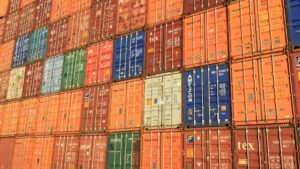
On a mark-to-market basis, most liners are operating in the red, according to analysis from investment bank Jefferies. Mark-to-market is an accounting practice that involves adjusting the value of an asset to reflect its value as determined by current market conditions.
“Container freight rates have fallen materially over the past six months and are hovering at 2020 lows across several routes,” Jefferies noted in a recent note to clients, calling for a “major supply response” to right-size the market.
Recent quarterly announcements from global liners Hapag-Lloyd and Ocean Network Express (ONE) show the changed fortunes in container shipping.
“The party is over,” Hapag-Lloyd CEO Rolf Habben Jansen told reporters at a briefing on Tuesday.
“Now we have to fight for every box again to get our ships full,” he said.
Japan’s ONE, meanwhile, recorded a 50% quarter-on-quarter drop in profits this week.
While much has been written about the declining spot rate environment, there is also now a record-breaking fall in long-term rates, according to Xeneta, a freight rate benchmarking platform.
Average long-term contracted rates dropped by 13.3% in January, Xeneta reported this week.
Xeneta CEO Patrik Berglund commented: “Global demand has fallen away, congestion has eased, equipment is available, and the macro-economic and geopolitical situations are, to say the least, complex.”
Analysts at Sea-Intelligence suggested the recent news of the dissolution of the 2M alliance featuring Maersk and MSC will increase the competitive pressure for global liners.
“A consequence of this, is an elevated risk of a protracted freight rate war to unfold in 2023. One indication of this, is the fact that we are still not seeing carriers being sufficiently aggressive on blank sailings post-Chinese New Year,” Sea-Intelligence stated in its most recent weekly report.
“January has been difficult for the carriers and there’s a real danger of some horrific times on the horizon,” Berglund from Xeneta commented. “With the market looking so depressed, overcapacity seems certain to loom large throughout the year.”
Judah Levine, head of research at Freightos, had some small cause for optimism later on this year.
“Projections that 2023 ex-Asia volume totals will only be slightly below 2022 imply expectations for a rebound in demand later this year,” Levine said.